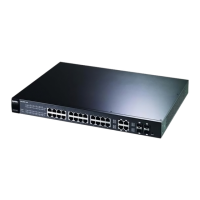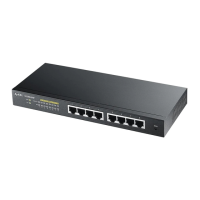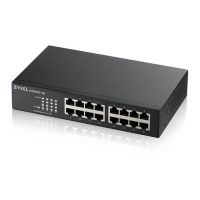GS1500-24P User’s Guide
67
CHAPTER 8
VLAN
8.1 Overview
This chapter shows you how to configure static, port-based VLANs.
8.2 What You Can Do
•Use the Static VLAN screen (Section 8.4 on page 70) to configure the static
VLAN settings on a port.
•Use the Port-Based VLAN screen (Section 8.5 on page 71) to configure the
port VLAN ID (PVID) for a port.
8.3 What You Need to Know
Read this section to know more about VLAN and how to configure the screens.
8.3.1 IEEE 802.1Q Tagged VLANs
A tagged VLAN uses an explicit tag (VLAN ID) in the MAC header to identify the
VLAN membership of a frame across bridges - they are not confined to the switch
on which they were created. The VLANs can be created statically by hand or
dynamically through GVRP. The VLAN ID associates a frame with a specific VLAN
and provides the information that switches need to process the frame across the
network. A tagged frame is four bytes longer than an untagged frame and
contains two bytes of TPID (Tag Protocol Identifier, residing within the type/length
field of the Ethernet frame) and two bytes of TCI (Tag Control Information, starts
after the source address field of the Ethernet frame).
The CFI (Canonical Format Indicator) is a single-bit flag, always set to zero for
Ethernet switches. If a frame received at an Ethernet port has a CFI set to 1, then
that frame should not be forwarded as it is to an untagged port. The remaining
twelve bits define the VLAN ID, giving a possible maximum number of 4,096
VLANs. Note that user priority and VLAN ID are independent of each other. A

